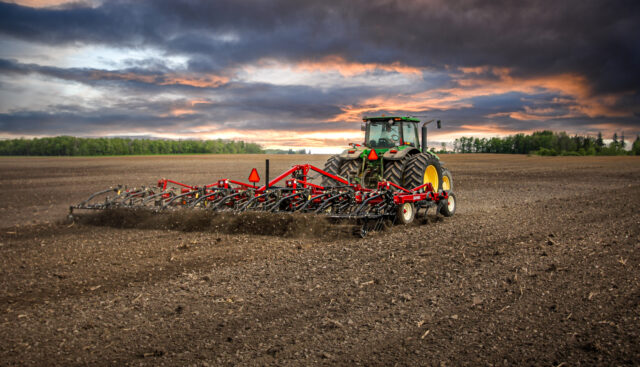Josh Buehlow and his Paul father grow corn and soybeans on roughly 2,200 acres in rolling hills in South Western Ontario near the town of Ayr. Efficiency is a big deal for the Buehlow’s as they work to get the most out of their time and equipment.
Roughly a decade ago, the Buehlow’s used a Salford RTS vertical tillage tool to prepare residue and help warm the soil for spring planting operations. After a few seasons, the Buehlow’s found the RTS didn’t work the ground thoroughly enough on some of their heavier soil types.
Over the next few years, the Buehlow’s tried different combinations of tillage equipment to work their land. They used a deep ripper, a cultivator, and a “disc style” vertical tillage implement. However, the Buehlow’s still weren’t satisfied with their tillage options. When they found out that Salford had upgraded the RTS, they went to their local dealer to see the changes. The RTS grew into six unique tillage machines call the Independent Series. Each I-Series model uses the RTS’s vertical tillage principles and has independently mounted blades, like the RTS. I-Series models start with different blades, blade mounting, and blade spacing. They can be equipped with enhanced finishing systems, and select models can carry shanks for more aggressive tillage or application.
The Buehlow’s purchased a Salford I-2200, heavy-duty blade mounts with 22-inch wavy coulters and 5-inch blade spacing. They also added the hydraulically adjustable SwitchBlade tillage shanks on 15-inch spacing so that they could till deeper, level more, and create more soil disturbance in the fall. In the spring, they’re able to hydraulically raise the shanks to run the machine for low-disturbance, high-speed seedbed preparation.
“We traded in three pieces of tillage equipment, and now this one-piece does everything that we need,” says Josh Buehlow. “We really like the job this machine does on our soil types. It allows us great versatility among all soil types to get the job done. We typically use this machine on every acre. If we’re planting corn into soybean stubble, we’ll spread our commercial fertilizer or manure and then use this machine to incorporate the fertilizer or manure into the soil and then follow-up with the planter. The finish is extremely smooth, and it’s a great seedbed to plant into.”
Josh noted that the I-2200 was more robust than the RTS, but it created the same level fields they had gotten used to from their old RTS. “One of the biggest things that we loved about our 570 RTS back in the day was how smooth our fields were. We never had smoother fields. So when we came back to the I-2200, that was one of the biggest things we were looking forward to. We noticed a huge difference when we were combining soybeans… we’re able to get every last bean because our fields are super smooth, and since they are smoother, we’re able to travel faster and still get that perfect cut.”
The Buehlow’s also found their I-2200 saved them time and money compared to their “vertical disc”. Their 31 foot I-2200 used less fuel than their other tillage equipped and has coved as many as 400 acres in a day. Salford’s vertical tillage design can work in a broader range of soil moisture conditions to warm and dry the soil and increase the window for planting operations. Josh noted that the I-2200 doesn’t breakdown often, and the ease of servicing the independently mounted blades and bearings means less downtime. Josh also noted the I-2200 was more operator-friendly than their disc-style machine. A few years back, they had a hired hand doing their tillage work with a “disc style” vertical tillage tool. The operator was experiencing a lot of downtime due to plugging the machine. This also led to sub-standard fieldwork with clumps and bunches of residue that would interfere with the planter. “I figure we probably paid him close to a day’s worth of labor for just hamming stones out of that machine, so we were losing productivity out of it, and by going to this I-2200, we don’t’ have issues like that anymore. Stalks and stuff flow through, and there’s no way that stones can get jammed.”
The Buehlow’s moved away from the Salford RTS because it didn’t mix enough soil and residue or level well enough on some of their ground. Now that they have moved back to a Salford, they’ve found that many of the things they liked about the RTS are common in the bigger, more durable I-2200. Still, it meets all of their tillage needs and improves the efficiency of their operation.
